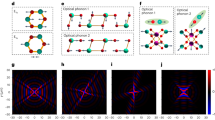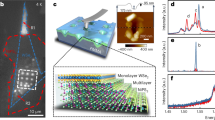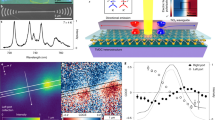Abstract
Control over light propagation and localization in photonic crystals offers wide applications ranging from sensing and on-chip routing to lasing and quantum light–matter interfaces. Although in electronic crystals, magnetic fields can be used to induce a multitude of unique phenomena, the uncharged nature of photons necessitates alternative approaches to bring about similar control over photons at the nanoscale. Here we experimentally realize pseudomagnetic fields in two-dimensional photonic crystals through engineered strain of the lattice. Analogous to strained graphene, this induces flat-band Landau levels at discrete energies. We study the spatial and spectral properties of these states in silicon photonic crystals at telecom wavelengths with far-field spectroscopy. Moreover, taking advantage of the photonic crystal’s design freedom, we realize domains of opposite pseudomagnetic field and observe chiral edge states at their interface. We reveal that the strain-induced states can achieve remarkably high quality factors despite being phase matched to the radiation continuum. Together with the high density of states and high degeneracy associated with flat bands, this provides powerful prospects for enhancing light–matter interactions, and illustrates the broad potential of psdeudomagnetic fields in the nanophotonic domain. This work, thus, establishes a new design principle to govern both on-chip and radiating light fields.
This is a preview of subscription content, access via your institution
Access options
Access Nature and 54 other Nature Portfolio journals
Get Nature+, our best-value online-access subscription
$29.99 / 30 days
cancel any time
Subscribe to this journal
Receive 12 print issues and online access
$209.00 per year
only $17.42 per issue
Buy this article
- Purchase on Springer Link
- Instant access to full article PDF
Prices may be subject to local taxes which are calculated during checkout




Similar content being viewed by others
Data availability
The data in this study are available via Zenodo at https://doi.org/10.5281/zenodo.10125585.
References
Wang, Z., Chong, Y., Joannopoulos, J. D. & Soljačić, M. Observation of unidirectional backscattering-immune topological electromagnetic states. Nature 461, 772–775 (2009).
Kane, C. L. & Mele, E. J. Size, shape, and low energy electronic structure of carbon nanotubes. Phys. Rev. Lett. 78, 1932–1935 (1997).
Guinea, F., Katsnelson, M. I. & Geim, A. K. Energy gaps and a zero-field quantum Hall effect in graphene by strain engineering. Nat. Phys. 6, 30–33 (2010).
Levy, N. et al. Strain-induced pseudo–magnetic fields greater than 300 Tesla in graphene nanobubbles. Science 329, 544–547 (2010).
Gomes, K. K., Mar, W., Ko, W., Guinea, F. & Manoharan, H. C. Designer Dirac fermions and topological phases in molecular graphene. Nature 483, 306–310 (2012).
Rechtsman, M. C. et al. Strain-induced pseudomagnetic field and photonic Landau levels in dielectric structures. Nat. Photon. 7, 153–158 (2013).
Song, W. et al. Dispersionless coupling among optical waveguides by artificial gauge field. Phys. Rev. Lett. 129, 053901 (2022).
Bellec, M., Poli, C., Kuhl, U., Mortessagne, F. & Schomerus, H. Observation of supersymmetric pseudo-Landau levels in strained microwave graphene. Light Sci. Appl. 9, 146 (2020).
Jia, H. et al. Experimental realization of chiral Landau levels in two-dimensional Dirac cone systems with inhomogeneous effective mass. Light Sci. Appl. 12, 165 (2023).
Wang, W. et al. Moiré fringe induced gauge field in photonics. Phys. Rev. Lett. 125, 203901 (2020).
Jamadi, O. et al. Direct observation of photonic Landau levels and helical edge states in strained honeycomb lattices. Light Sci. Appl. 9, 144 (2020).
Duan, G. et al. Synthetic gauge fields and Landau levels in acoustic Moiré superlattices. Appl. Phys. Lett. 123, 021702 (2023).
Wen, X. et al. Acoustic Landau quantization and quantum-Hall-like edge states. Nat. Phys. 15, 352–356 (2019).
Yang, Z., Gao, F., Yang, Y. & Zhang, B. Strain-induced gauge field and Landau levels in acoustic structures. Phys. Rev. Lett. 118, 194301 (2017).
Abbaszadeh, H., Souslov, A., Paulose, J., Schomerus, H. & Vitelli, V. Sonic Landau levels and synthetic gauge fields in mechanical metamaterials. Phys. Rev. Lett. 119, 195502 (2017).
Peri, V., Serra-Garcia, M., Ilan, R. & Huber, S. D. Axial-field-induced chiral channels in an acoustic Weyl system. Nat. Phys. 15, 357–361 (2019).
Guglielmon, J., Rechtsman, M. C. & Weinstein, M. I. Landau levels in strained two-dimensional photonic crystals. Phys. Rev. A 103, 013505 (2021).
Salerno, G., Ozawa, T., Price, H. M. & Carusotto, I. How to directly observe Landau levels in driven-dissipative strained honeycomb lattices. 2D Mater. 2, 034015 (2015).
Salerno, G., Ozawa, T., Price, H. M. & Carusotto, I. Propagating edge states in strained honeycomb lattices. Phys. Rev. B 95, 245418 (2017).
Hafezi, M., Demler, E. A., Lukin, M. D. & Taylor, J. M. Robust optical delay lines with topological protection. Nat. Phys. 7, 907–912 (2011).
Schine, N., Ryou, A., Gromov, A., Sommer, A. & Simon, J. Synthetic Landau levels for photons. Nature 534, 671–675 (2016).
Borregaard, J., Sørensen, A. S. & Lodahl, P. Quantum networks with deterministic spin–photon interfaces. Adv. Quantum Technol. 2, 1800091 (2019).
Krauss, T. F. Why do we need slow light? Nat. Photon. 2, 448–450 (2008).
Smirnova, D., Leykam, D., Chong, Y. & Kivshar, Y. Nonlinear topological photonics. Appl. Phys. Rev. 7, 021306 (2020).
Yang, Y. et al. Photonic flatband resonances for free-electron radiation. Nature 613, 42–47 (2023).
Schomerus, H. & Halpern, N. Y. Parity anomaly and Landau-level lasing in strained photonic honeycomb lattices. Phys. Rev. Lett. 110, 013903 (2013).
Lledó, C., Carusotto, I. & Szymanska, M. Polariton condensation into vortex states in the synthetic magnetic field of a strained honeycomb lattice. SciPost Phys. 12, 068 (2022).
Sheng, C. et al. Bound vortex light in an emulated topological defect in photonic lattices. Light Sci. Appl. 11, 243 (2022).
Gorlach, M. A. et al. Far-field probing of leaky topological states in all-dielectric metasurfaces. Nat. Commun. 9, 909 (2018).
Parappurath, N., Alpeggiani, F., Kuipers, L. & Verhagen, E. Direct observation of topological edge states in silicon photonic crystals: spin, dispersion, and chiral routing. Sci. Adv. 6, eaaw4137 (2020).
Barczyk, R. et al. Interplay of leakage radiation and protection in topological photonic crystal cavities. Laser Photonics Rev. 2022, 2200071 (2022).
Huang, Z.-T. et al. Pattern-tunable synthetic gauge fields in topological photonic graphene. Nanophotonics 11, 1297–1308 (2022).
Wu, L.-H. & Hu, X. Scheme for achieving a topological photonic crystal by using dielectric material. Phys. Rev. Lett. 114, 223901 (2015).
Kiriushechkina, S. et al. Spin-dependent properties of optical modes guided by adiabatic trapping potentials in photonic Dirac metasurfaces. Nat. Nanotechnol. 18, 875–881 (2023).
Ren, B. et al. Zero-energy edge states and solitons in strained photonic graphene. Phys. Rev. A 107, 043504 (2023).
Barik, S., Miyake, H., DeGottardi, W., Waks, E. & Hafezi, M. Two-dimensionally confined topological edge states in photonic crystals. New J. Phys. 18, 113013 (2016).
Reardon, C. P., Rey, I. H., Welna, K., O’Faolain, L. & Krauss, T. F. Fabrication and characterization of photonic crystal slow light waveguides and cavities. J. Vis. Exp. e50216 (2012).
Akhmerov, A. R. & Beenakker, C. W. J. Boundary conditions for Dirac fermions on a terminated honeycomb lattice. Phys. Rev. B 77, 085423 (2008).
Kohmoto, M. & Hasegawa, Y. Zero modes and edge states of the honeycomb lattice. Phys. Rev. B 76, 205402 (2007).
Ma, T. & Shvets, G. All-Si valley-Hall photonic topological insulator. New J. Phys. 18, 025012 (2016).
Hsu, C. W., Zhen, B., Stone, A. D., Joannopoulos, J. D. & Soljačić, M. Bound states in the continuum. Nat. Rev. Mater. 1, 16048 (2016).
Lodahl, P., Mahmoodian, S. & Stobbe, S. Interfacing single photons and single quantum dots with photonic nanostructures. Rev. Mod. Phys. 87, 347 (2015).
Settnes, M., Leconte, N., Barrios-Vargas, J. E., Jauho, A.-P. & Roche, S. Quantum transport in graphene in presence of strain-induced pseudo-Landau levels. 2D Mater. 3, 034005 (2016).
COMSOL Multiphysics version 5.2. COMSOL AB https://www.comsol.com/ (2015).
Acknowledgements
We thank S. Arora and D. Muis for fruitful discussions. This work is part of the research programme of the Netherlands Organisation for Scientific Research (NWO). We acknowledge support from the European Research Council (ERC) Starting Grant no. 759644-TOPP and Advanced Investigator grant no. 340438-CONSTANS.
Author information
Authors and Affiliations
Contributions
R.B. and E.V conceived the project. R.B. fabricated the devices, carried out the measurements, performed the data analysis and modelling, and drafted the paper. E.V. and L.K. supervised the project. All authors contributed extensively to the interpretation of the results and writing of the paper.
Corresponding author
Ethics declarations
Competing interests
The authors declare no competing interests.
Peer review
Peer review information
Nature Photonics thanks the anonymous reviewers for their contribution to the peer review of this work.
Additional information
Publisher’s note Springer Nature remains neutral with regard to jurisdictional claims in published maps and institutional affiliations.
Extended data
Extended Data Fig. 1 Far-field Fourier spectroscopy.
Schematic depiction of the experimental far-field Fourier spectropolarimetry setup used for angularly resolved measurement of the photonic crystals’ band dispersion. See Methods for details and abbreviations.
Extended Data Fig. 2 Symmetry breaking to control radiative coupling.
Measured (top) and simulated (bottom) bands of Landau levels in PhCs with varying unit cell shrinking factor ρ, all at κ = 0.125. The linewidth in the simulations is scaled by a factor two for enhanced visibility. The linewidth increases with decreasing ρ.
Extended Data Fig. 3 Tailoring Landau levels via strain.
Measured (top) and simulated (bottom) bands of Landau levels in PhCs with increasing strain magnitude κ, all at ρ = 0.98. The gap at small κ is due to the sub-lattice symmetry breaking.
Extended Data Fig. 4 Landau level localization and polarization.
Position- and polarization-dependent excitation of photonic Landau levels, where the displacement in x relative to the lattice center and the polarization state of the incident beam (linear horizontal (X), linear vertical (Y), right-handed circular (R) and left-handed circular (L)) are indicated (ρ = 0.98 and κ = 0.125 in these measurements).
Extended Data Fig. 5 Quality factors of pristine lattices.
a, Numerically retrieved bands of a pristine strained photonic crystal featuring Landau levels, with color-coded quality factors (ρ = 1.00, κ = 0.125). b, Same as a, for a photonic crystal featuring chiral edge states.
Extended Data Fig. 6 Landau level losses versus wavevector.
Numerically retrieved contributions of radiative and in-plane losses to the total linewidth of the zeroth Landau level (left), corresponding to the section of the band highlighted in red (right). For large ky, the in-plane losses exceed the radiative losses to the top and bottom of the PhC slab, which reduces the visibility of the bands in the experiment as they become under-coupled to the free-space radiation.
Extended Data Fig. 7 Tailoring chiral edge states via strain.
Measured (top) and simulated (bottom) bands of chiral edge states in PhCs with increasing strain magnitude κ, all at ρ = 0.98.
Extended Data Fig. 8 Polarization and position dependence of chiral edge states.
The incident polarization state is denoted as X (linear horizontal), R (right-hand circular), or L (left-hand circular) besides each row. The transverse position of the focus with respect to the interface between the domains is shown above each column. The strain magnitude is κ = 0.125 for all panels. For right- and left-handed circularly polarized light, we see signatures of spin-orbit coupling in the chiral edge states. At a fixed frequency, one can selectively couple into forward or backward propagating modes by changing the helicity (pseudospin) of the incident beam. However, we note that the same state can be launched with opposite helicity at the other side of the center. Moreover, the panels show that two different edge states can be excited at the same location with equal helicity, despite having opposite group velocity.
Extended Data Fig. 9 Sub-lattice symmetry breaking and edge state dispersion.
Measured (top) and simulated (bottom) bands of chiral edge states in PhCs with varying unit cell shrinking factor ρ, all at κ = 0.125. The linewidth is scaled by a factor two for enhanced visibility. The sub-lattice symmetry breaking leads to avoided crossings around the Γ point in the edge state dispersion.
Supplementary information
Supplementary Information
Supplementary Sections I and II and Figs. 1 and 2.
Rights and permissions
Springer Nature or its licensor (e.g. a society or other partner) holds exclusive rights to this article under a publishing agreement with the author(s) or other rightsholder(s); author self-archiving of the accepted manuscript version of this article is solely governed by the terms of such publishing agreement and applicable law.
About this article
Cite this article
Barczyk, R., Kuipers, L. & Verhagen, E. Observation of Landau levels and chiral edge states in photonic crystals through pseudomagnetic fields induced by synthetic strain. Nat. Photon. (2024). https://doi.org/10.1038/s41566-024-01412-3
Received:
Accepted:
Published:
DOI: https://doi.org/10.1038/s41566-024-01412-3



